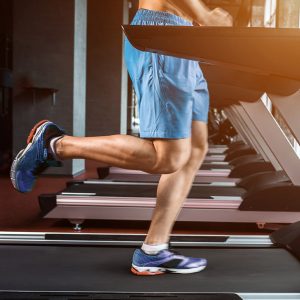Gait and Running Analysis
What Is A Video Running Analysis?
Video running analysis is a tool used by physical therapists to assess a runner’s biomechanics and technique. Any type of runner (recreational or elite, new or seasoned, etc.) can have a running analysis performed! Video running analysis can be used for individuals with pain or injuries to help determine if there are biomechanical issues with their run technique. Video running analysis can also be used for pain free runners as a performance enhancing tool to improve their efficiency and technique.
A patient runs on our treadmill at specific speeds (speeds are predetermined based on discussion with the physical therapist). The patient’s run is then assessed in real time and is also filmed from 5 different vantage points. The PT then uses specialized software to review the video and perform an in depth examination and analysis of the runner’s biomechanics. The information gleaned from the analysis is then used to help formulate the patient’s physical therapy plan of care and specific exercises are provided to the patient to aid in correcting run technique.
What Are The Signs You May Need A Biomechanical Analysis?
 All runners can have a video running analysis performed! It is particularly helpful for those who have pain during or after their runs or for those dealing with and/or recovering from injury.
All runners can have a video running analysis performed! It is particularly helpful for those who have pain during or after their runs or for those dealing with and/or recovering from injury.
What Is A Gait Analysis Used For?
Video running analysis is used to examine a patient’s run and determine if there are biomechanical breakdowns and issues with form and technique taking place. The analysis allows us to pinpoint where in the run the dysfunction is taking place and how that dysfunction is effecting and contributing to the runner’s pain/injury or limiting their efficiency.
What Would A Patient Gain By Getting A Gait Analysis?
By undergoing video running analysis the patient would gain insight into their running technique and be able to understand exactly where mechanical breakdown and issues with form are taking place. With this information the patient is able to participate in specific PT guided exercises and drills to correct those dysfunctions found. They can then continue running or return to running pain free, with greater efficiency, and a decreased chance of injury.
What Can You Expect During A Video Biomechanic Analysis?
Prior to the video running analysis the patient participates in a physical therapy evaluation. It is during that time that the PT and patient will discuss the patient’s running and exercise regimen. Based on the specifics of each runner’s training habits, the amount of time spent on the treadmill and the speeds the patient will run at are determined. Once that information is decided, the patient runs on the treadmill and is filmed from 5 different vantage points at 1-4 different speeds (depending on what the patient and PT decided). Once filming is complete, the PT uses specialized software to examine the runner’s technique and identify areas of mechanical breakdown and form dysfunction. The PT looks at all joints of the body during the run, particularly the ankles, knees, hips, pelvis, spine, shoulders and elbows. The PT takes images from the video during different phases of the run and physically draws in angles at the different joints of the body to highlight side to side (left vs. right) asymmetries and areas of biomechanical break down.
How Are The Results Of A Video Running Analysis Presented?
After the run is filmed it takes about 1 week to receive the complete analysis. It will be presented like a report. It typically begins with information on the patient’s run technique (cadence, footstrike, run phases examined, etc.) It then consists of images of the patient running at different speeds, from different angles, during specific phases of their run where biomechanical issues are seen taking place. The issues seen in the images are described so that the patient understands where and what dysfunction is happening. The analysis ends with recommendations for patient’s training to correct biomechanics and improve their run efficiency.
Are There Related Treatments Or PT Plans After One Goes Through A Gait Analysis?
If the patient is a pain free runner looking to enhance their running performance, it is best to participate in at least one follow up session following a run analysis so that the PT can explain the analysis in depth and can review the recommended exercises and training drills.
If the patient is working with their PT to rehabilitate an injury, the information learned during the running analysis will be applied to their plan of care and used to help progress them towards their return to running goals!
Key Takeaways About Video Biomechanical Running Analysis
- A video running analysis can be performed for all types of runners! A patient may participate in video running analysis if they are recovering from pain, an injury, or are post-surgical (once they are cleared for running by their surgeon), OR if they are pain free/injury free runners looking to enhance their performance and improve technique
- Video running analysis allows for in depth examination of a patient’s running mechanics at various (predetermined) speeds, from 5 different vantage points. Images from different phases of the run are then taken from the video and joint angles are drawn in to highlight biomechanical dysfunctions and asymmetries.
- Patient’s will receive a detailed report on their run analysis so that they can review all the information and read the PT’s recommendations
- PT guided exercises and training drills are provided to each patient based on their specific needs and goals. There are no generic plans or programs handed out. Each patient’s plan is customized!

